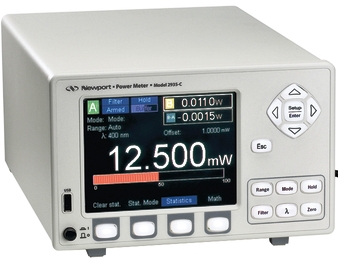
|
|
The Newport 1936-C power/energy meter has the ability to handle repetition-rates of up to 10 kHz at a sampling rate of 250 kHz. This means that even reasonably high speed dynamical phenomena can be seen using the meter, eliminating a need for an oscilloscope in many cases. Pulse, peak-to-peak and DC source measurements can be displayed in units of W, dBm, dB, J, A, and V. Users can select from 6 display colors to match their specific lighting conditions and colors of their laser safety eyewear. Measurements can also be displayed in various display formats, such as numeric, graphic, bar and strip charts. The 1936-C High-Performance Power/Energy Meter is compatible with detectors having an output of voltage or current, provided the proper electrical connection is implemented and the optical meter specifications are not exceeded for voltage and current sensitivity range. Specifications. Compatible, Hot-swappable Newport Detectors: 918D, 818P, 818E, and 818 (w/adapter). Sampling Rate (kHz): 250. Measurement Rate (kHz): 10. Display Refresh Rate (Hz): 20. Maximum Rep Rate (kHz): 10 (Pyroelectric Detectors). Maximum Rep Rate (kHz): 20 (Photodiode Detectors, Peak to Peak Power). Resolution (% of Full Scale): 0.0004. CW Accuracy (%): ±0.1. Accuracy (%): ±1 (Peak to Peak, Pulse to Pulse, Integration). Frequency Measurement Range: 1 Hz to 250 kHz. Maximum Detector Input Current (mA): 25. Maximum Detector Input Voltage (V): 130. Display Type: 5.7” Graphical TFT LCD, 1/4 VGA. Display Formats: 20 mm Numeric, Bar Chart, Min/Max Bar, Statistics. Communication Interfaces: USB and RS-232.
|